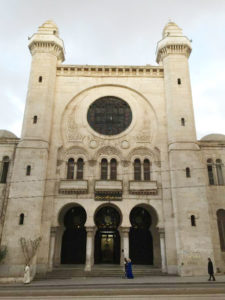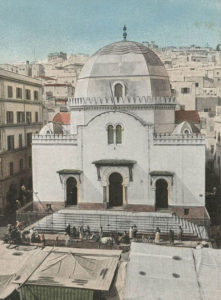 Jewish Population
Jewish Population
1963: 140,000 | 2020: 0
The history of the Jewish community of Algeria, which dates to the 1st century CE. Many Sephardic Jews were forced to take refuge in Algeria from the persecutions in Spain of Catalonia, Valencia and Balearic Islands in 1391 and the Spanish Inquisition in 1492.
In the 16th century there were large Jewish communities in places such as Oran, Bejaïa and Algiers. Jews were also present in the cities of the interior such as Tlemcen and Constantine and as far spread as Touggourt and M’zab in the south, with the permission of the Muslim authorities. Some Jews in Oran preserved Ladino language—which was a uniquely conservative dialect of Spanish—until the 19th century.
 Between the 16th and 17th centuries, richer Jews from Livorno in Italy started settling in Algeria. Commercial trading and exchanges between Europe and the Ottoman Empire reinforced the Jewish community. Later again in the 19th century, many Sephardic Jews from Tetouan settled in Algeria, creating new communities, particularly in Oran.
Between the 16th and 17th centuries, richer Jews from Livorno in Italy started settling in Algeria. Commercial trading and exchanges between Europe and the Ottoman Empire reinforced the Jewish community. Later again in the 19th century, many Sephardic Jews from Tetouan settled in Algeria, creating new communities, particularly in Oran.
In 1830, the Algerian Jewish population was between 15,000 and 17,000, mostly congregated in the coastal area. Some 6,500 Jews lived in Algiers, 2,000 in Oran; 3,000 in Constantine; and 1,000 in Tlemcen. In 1845, the French colonial government reorganized communal structure. The French government granted the Jews, who by then numbered some 33,000, French citizenship in 1870 under the décret Crémieux. Within a generation, despite initial resistance, most Algerian Jews came to speak French rather than Arabic or Ladino, and they embraced many aspects of French culture. Southern Algerian Jews, were subject to restricted and decreased rights compared to their Northern Jewish counterparts.
One of the first moves of the pro-German Vichy regime was to revoke the effects of the Crémieux Decree, on October 7, 1940, thereby abolishing French citizenship for Algerian Jews. The Vichy regime’s laws ensured that Jews were forbidden from a number of jobs, and their children were not allowed to go to the public schools. Antisemitic legislation was applied more severely in Algeria than France itself.
 In addition to the discriminatory and antisemitic laws faced by Jews all over Algeria, some 2,000 Jews were placed in concentration camps at Bedeau and Djelfa. The camp at Bedeau, near Sidi-bel-Abbes, became a place for the concentration of Jewish Algerian soldiers, who were forced to perform hard labor. These prisoners formed the “Jewish Work Group,” and worked on a Vichy plan for a trans-Saharan railroad; many died from hunger, exhaustion, disease, or beatings.
In addition to the discriminatory and antisemitic laws faced by Jews all over Algeria, some 2,000 Jews were placed in concentration camps at Bedeau and Djelfa. The camp at Bedeau, near Sidi-bel-Abbes, became a place for the concentration of Jewish Algerian soldiers, who were forced to perform hard labor. These prisoners formed the “Jewish Work Group,” and worked on a Vichy plan for a trans-Saharan railroad; many died from hunger, exhaustion, disease, or beatings.
Many young Jews joined the Algerian resistance movement, founded by Jews in 1940. On November 8, 1942, the Algerian resistance to the Vichy government took part in the takeover of Algiers in preparation for the Allied liberation of North Africa, known as “Operation Torch.” Of the 377 resistance members who took Algiers, 315 were Jewish. In November 1942, British and American soldiers landed and took control of Algiers and the rest of Algeria. However, Jews were not returned all of their former civil rights and liberties, nor their French citizenships until 1943.
Once Algeria gained its independence in 1962, it passed the Nationality Code in 1963, depriving non-Muslims of citizenship. Approximately 130,000 Jews left Algeria. By 1969, fewer than 1,000 Jews were still living in Algeria. By 1975 the government had seized all but one of the country’s synagogues and converted them to mosques or libraries.
Today there are no functioning synagogues in Algeria; Jewish cemeteries are wrecked and abandoned; and Young Algerians have no idea that more than 130,000 Jews once lived in their country.